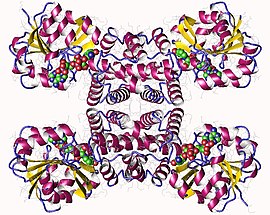(Redirected from
4-hydroxybutyrate dehydrogenase)
| 4-hydroxybutyrate dehydrogenase | |||||||||
|---|---|---|---|---|---|---|---|---|---|
 | |||||||||
| Identifiers | |||||||||
| EC no. | 1.1.1.61 | ||||||||
| Databases | |||||||||
| IntEnz | IntEnz view | ||||||||
| BRENDA | BRENDA entry | ||||||||
| ExPASy | NiceZyme view | ||||||||
| KEGG | KEGG entry | ||||||||
| MetaCyc | metabolic pathway | ||||||||
| PRIAM | profile | ||||||||
| PDB structures | RCSB PDB PDBe PDBsum | ||||||||
| Gene Ontology | AmiGO / QuickGO | ||||||||
| |||||||||
In enzymology, a 4-hydroxybutyrate dehydrogenase ( EC 1.1.1.61) is an enzyme that catalyzes the chemical reaction
- 4-hydroxybutanoate + NAD+ succinate semialdehyde + NADH + H+
The two substrates of this enzyme are therefore 4-hydroxybutanoic acid, and NAD+, whereas its 3 products are succinate semialdehyde, NADH, and H+.
This enzyme belongs to the family of oxidoreductases, specifically those acting on the CH-OH group of donor with NAD+ or NADP+ as acceptor. [1] The systematic name of this enzyme class is 4-hydroxybutanoate:NAD+ oxidoreductase. This enzyme is also called gamma-hydroxybutyrate dehydrogenase. This enzyme participates in butanoate metabolism and the degradation of the neurotransmitter 4-hydroxybutanoic acid. [2]
References
- ^ Nirenberg MW, Jakoby WB (1960). "Enzymatic utilization of gamma-hydroxybutyric acid". J. Biol. Chem. 235: 954–960. PMID 14427301.
- ^ Kaufman EE, Nelson T (1991). "An overview of gamma-hydroxybutyrate catabolism: the role of the cytosolic NADP+-dependent oxidoreductase EC 1.1.1.19 and of a mitochondrial hydroxyacid-oxoacid transhydrogenase in the initial, rate-limiting step in this pathway". Neurochem. Res. 16 (9): 965–974. doi: 10.1007/BF00965839. PMID 1784339.
